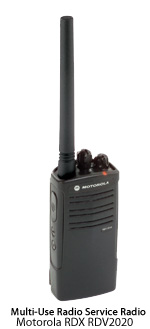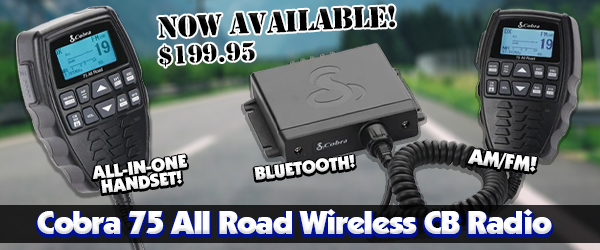 Do you need a high powered two way radio, but don't want to deal with the hassle of licensing? MURS may be the answer, particularly if you plan to use the radio outdoors where VHF frequencies are most effective.
Do you need a high powered two way radio, but don't want to deal with the hassle of licensing? MURS may be the answer, particularly if you plan to use the radio outdoors where VHF frequencies are most effective.
The Multi-Use Radio Service (MURS) is a two-way radio service consisting of five frequencies in the VHF spectrum. Established by the U.S. Federal Communications Commission (FCC) in the fall of 2000, MURS is a radio service allowing for "licensed by use" operation, meaning that a FFC issued license is not necessary to operate a MURS transmitter. The FCC formally defines MURS as "a private, two-way, short distance voice or data communications service for personal or business activities of the general public".
There are some limitations to MURS: radio power is limited to 2 watts, MURS stations may not be connected to the public telephone network, radio repeaters are not permitted, and the highest point of any MURS antenna must not be more than 60 feet above the ground or 20 feet above the highest point of the structure on which it is mounted.
Since MURS exists within the VHF spectrum, it has the potential to become very popular among the traveling community and outdoor enthusiasts. VHF characteristics are ideal for short-distance ground communication, with a range generally somewhat farther than line-of-sight. Although there are limitations on transmitter power output and antenna height, there are no restrictions on the use of external antennas. The range for vehicle-to-vehicle communications with MURS can be much greater than that for the Family Radio Service (FRS). Outdoor activities are benefited by the increased range over the FRS, allowing for base camps to utilize antennas to stay in contact with campers and emergency personnel.
MURS operation is authorized anywhere a CB station is authorized.
- Within or over any area of the world where radio service are regulated by the FCC
- Any other area of the world, except within the territorial limits of areas where radio services are regulated by either an agency of the United States other than the FCC or any foreign government (Subject to either parties rules)
- Aboard any vessel of the United States, with the permission of the captain, while the vessel is traveling either domestically or in international waters
MURS operation is not authorized aboard aircraft in flight.
MURS stations may transmit voice or data signal as permitted in FCC regulation Section 95.631.
Determined quickly whether a radio is legal to use on MURS:
- If the radio is Part 95 certified and operates on MURS frequencies
- If the radio was Part 95 certified prior to November 12, 2002 and transmits no more than 2 watts, and has no external control to increase power above 2 watts and only operates wideband on the 154 MHz frequencies (all parts must be true)
- If the Radio was Part 90 certified prior to November 12, 2002 and transmits no more than 2 watts and has no external control to increate power above 2 watts and does not narrowband on the 151 MHz and 154 MHz frequencies or narrowband on 151 MHz and wideband on 154 MHz frequencies (all parts must be true)
The following are the frequencies authorized for use by the MURS:
| Frequency | Authorized Bandwidth |
|---|---|
| 151.820 MHz | 11.25 kHz |
| 151.880 MHz | 11.25 kHz |
| 151.940 MHz | 11.25 kHz |
| 154.570 MHz (also part of business band) | 20.00 kHz |
| 154.600 MHz (also part of business band) | 20.00 kHz |
Click here for a list of radios that we currently offer supporting the MURS frequencies.
Related Resources
The first mobile MURS radio from Wouxun is here!
Best MURS Two Way Radios of 2020
Looking for a MURS Compatible Radio?
MURS Capable Two Way Radios
Motorola Releases Two New MURS Radios
Introducing the Wouxun KG-805 Professional GMRS and MURS Radios
The Two Way Radio Show TWRS-11 - All About MURS
The Two Way Radio Show TWRS-145 - New GMRS and MURS Radios


















Im confused ?
MURS radios were used widely in the 1980's where you requested use of freqs use through FCC .
There was a small fee and were good for few years.
Used hand held radios but company mainly used 25 watt mobils in trucks for past owned
lumber yard 25 mile radius in area. We Had Motorola Base and antenna at 60 ft
which we were athorized useas per all old records show start of 1989 at
up to 50 watts mobil or base. we would recieve a renewal and pay fee every few years.
Last was 1998. Still have few these maxtrac's programed to 154.600 thinking using
not as murs bussiness anymore but on farm.
There has to be more power then 2 watts on mobil radio's?
If not when they change this?
If not GMRS with UHF band Mobils a possibilty vertex, kenwood or motorola .
Lots bad reviews of cheap china radios that are over priced.
Please put commeny on post. thank you.
Actually, MURS did not exist as a service in the 1980's. the FCC created it as its own service in the year 2000, separate from the business band. MURS uses the 5 frequencies listed in the article above. Frequencies such as 154.600 that were previously assigned exclusively to business radios are now considered part of MURS and are licensed by rule. This audiogram called What Is a MURS Radio? explains the MURS (Multi Use Radio Service) in detail.
Since fcc is involved In soo much new tech business tv etc ..
I'd just get a 40 to 50 watt Chinese mobile vhf ..they all cover expanded freq including MURS and enjoy real good range for great price !
This would be highly inadvisable. MURS has a 2 watt power limit, and the FCC requires radios that operate on MURS frequencies to be Part 95J type accepted for use on the service. Instead, we recommend using only radios specifically FCC type accepted and approved for the Multi-Use Radio Service when transmitting on MURS.
Mike M.:
Even with CTCSS (A.K.A. "PL" tone) installed/enabled, it is also against the FCC rules to transmit over anybody else who is occupying the channel you are using.
So, it is in your best interest to A) Install the radio(s) with a means to disable the CTCSS upon lifting the microphone, or B) Press the MON(itor) button for a few seconds before transmitting, to (hopefully), ascertain whether the frequency is in use.
GMRS Lic. went down to I believe $70 for 10yrs for your whole family to use. I live in Damascus MD and I was able to hit a repeater in Alexandria VA about 40 miles. Using a repeater compatible radio like Kenwood Tk-860 mobilke 30W or a Baofeng hand unit.
*We are considering using a MURS frequency during a fire emergency in a Rural area when power is out...*
It has to be a literal life and death situation. Even then you're pushing it. I would recommend you either setup a CB relay group (no license, cheap equipment, and good range). Next best is GMRS because it gives you 2 possibilities: low power with a power mobile radio for $15 that can be used to listen with. Or pay for a $50 license go with 50 watts legally to cover a 2-3 miles. Your best option is setup a HAM group for the best quality and distance.
@Neal Sternberg: The only law I know close to what you are talking about is 47 CFR Part 97 Section 97.403 which states the following: No provision of these rules prevents the use by an amateur station of any means of radio communication at its disposal to provide essential communication needs in connection with the immediate safety of human life and immediate protection of property when normal communication systems are not available.
There is also this law here which is a law regulating fixed microwave radio services:
§ 101.203 Communications concerning safety of life and property.
(a) Handling and transmission of messages concerning the safety of life or property which is in imminent danger must be afforded priority over other messages.
(b) No person may knowingly cause to be transmitted any false or fraudulent message concerning the safety of life or property, or refuse upon demand immediately to relinquish the use of a radio circuit to enable the transmission of messages concerning the safety of life or property which is in imminent danger, or knowingly interfere or otherwise obstruct the transmission of such messages.
No, the FCC will most probably not grant you an individual waiver to the Service (MURS) limits. The technical specs are set for everyone. If you need more power, you will have to select a different radio Service (such as GMRS, Business, Special Emergency, or other). Decide if you want or need handhelds or mobiles, or just a 5 W handheld on a mobile antenna. Mobile antennas are about 10 times more efficient than a 'rubber duck' antenna on handheld, and even more so if the handheld is being used on a 'rubber duck' antenna from inside of a car, and even worse from inside of one car to the inside of another car, and even worse on VHF (MURS) than UHF (GMRS).
We are considering using a MURS frequency during a fire emergency in a Rural area when power is out, phones are not available and to communicate between neighbor leaders. Life and/or property would be at risk, we’re lead to believe the FCC will allow greater than 2 watts of power in those situations, can you verify that.
I use MURS motorolas when shooting urbex photography with other photographers. Great for those places with no cell service, coordinating and checking in with travel companions. MURS radios are way more durable than FRS units and we get over 24 hours of usage per charge on the lithium batteries.
It really depends on what antenna and height. On 2 watts VHF MURS, the antenna on average ia about 10 feet off of the ground. You might get about 2-3 miles based on the surrounding area. In PA, I get about 1-2 miles. In places like Texas where it is flat, maybe 3-5 miles at the most, again depending the gain of the antenna and how high the antenna is off the ground.
You have inaccurate information posted in your comment. G.M.R.S is limited to 50 Watt transmitter power output not 5 watts. Also all 5 frequencies are former Part 90 business band frequencies. I'm not saying one way or another that MURS is better or worse than GMRS they both have their perks and their weakness's. VHF is better for rural area's with lots of foliage and UHF is better for urban areas with tall buildings. No matter bad Service you use. Part 80, Part 95, Part 90, or Part 97 among the ones I use daily but there are many more. In both services you are allowed the use of external High gain antennas as well. GMRS is only limited to 5Watts ERP on the 7 shared FRS frequencies.
Good piece . I was enlightened by the analysis
Great review. Are you into any other forms of Radio? Where approx.?
Seeking MURS Data Transceiver with built-in or attachable messaging display screen and keyboard.. U gots?
The legal use of MURS will depend on the laws and rules of your country. As stated in the article, MURS has five channels and a limit of 2 Watts. Range will depend on several factors, including your location, altitude, the structures around you, environmental conditions, the antenna on your radio and how you hold it. You might get 2 or 3 miles, you might get 200 or 300 feet. There is no set range limit as it will depend on all of these factors combined.
For a more in-depth discussion, listen to The Two Way Radio Show Podcast TWRS-11 - All About MURS.
I am working in Transshipment port and we have some issue with the communication voice traffic due to limited channel given to us by the telecommunication company or the government handling the frequency . As per above comments, MURS does not required any subscription either from telecommunication or frequency distributor. Can you please advise what is range of the communication can reach by the radio, and how many units and channel can use at the same time.
Hi Col. Smith, yes we do carry a MURS radio. The Motorola RMM2050 MURS Two Way Radio is in stock with free shipping. We also carry a complete line of accessories for the RMM2050, including spare battery packs, belt clips and holsters. Give us a call at 800-584-1445 and we can help you order whatever you need at the best price for the package.
Hello,
Do you sell Motorola (or other quality brands) of MURS portable or handi-talkie radios?
If you do and could advise me of the cost per radio plus 2 or 3 spare battery packs per radio, I would appreciate it. if holsters or belt clips are available, that we be helpful, also.
Col. Randall Smith, KF5YMT/AAR6KQ, Commander
Civil Defense Nationwide Emergency Communications Network
What kind of range can I expect with 2 MURS portables in separate cars.
Thank You
What kind of range might I expect car to car with stock antenna on flat
ground? I realize I probably will put on external antennas. I do not
know much about MURS.
Thank You,
Jim